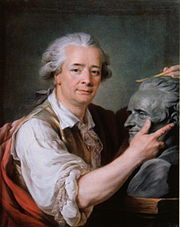Augustin Pajou
Augustin Pajou (born September 19, 1730 in Paris , † May 8, 1809 ibid) was an important French sculptor and sculptor of classicism .
From the age of 14 he attended the Royal Academy , where he was a student of the sculptor and sculptor Jean-Baptiste Lemoyne . At the age of 18 he won the Prix de Rome and the 1st prize of the Royal Academy . This gave him the opportunity to study in Rome and Italy for several years. The benevolence of the king and Madame du Barry earned him numerous commissions even after his return. In the 1760s he worked on the design of various public buildings, such as the Versailles Opera , the Palais Royal and the Palais de Justice . He was also very successful as a sculptor and sculptor. During the French Revolution he worked for a commission for the preservation of French monuments and spent three of the terrible years in the province, in Montpellier .
When Napoleon made the Villa Medici in Rome the seat of the French Academy in 1803 , he had Pajou make copies of the two Medici lions that had been on the stairs to the villa until 1789 and put them back in their old place.
Pajou was considered one of the most important sculptors of his time and part of his work is preserved in the great museums of the world.
Works
- Pluto and Cerberus , 1759, Louvre / Paris
- The Princess of Hessen-Homburg in front of the Altar of Immortality , 1759, Hermitage / St. Petersburg
- Calliope , around 1763, National Gallery / Washington
- Francis de Sales , 1767, Musée des Augustins / Toulouse
- Marquis de Marigny , 1767, Municipal Art Museum / Copenhagen
- Allegory of Queen Marie Leszczynska , around 1771, Louvre / Paris
- Two ideal female heads , around 1770, Getty Center / Los Angeles
- Buffon , 1773, Louvre / Paris
- Madame du Barry , 1773, Louvre / Paris
- Madame du Barry , Museum of Fine Arts / Boston
- Female bust , around 1774, Museum of Fine Arts / Boston
- Bellona , around 1775, Getty Center / Los Angeles
- Marie-Adelaide Hall , 1775, Frick Collection / New York
- Bossuet , 1779, Louvre / Paris
- Mercury , 1780, Louvre / Paris
- Madame Sedaine , 1781, Museum of Fine Arts / Boston
- Diogenes , 1781, Louvre / Paris
- The Queen Marie-Antoinette and the Dauphin , 1781, Royal Belgian Museum of Fine Arts, Brussels
- The painter Jean-Baptiste Le Prince , 1782, Royal Belgian Museum of Fine Arts, Brussels
- Élisabeth Vigée-Lebrun , 1783, Louvre / Paris
- Blaise Pascal , 1785, Louvre / Paris
- Nathalie de Laborde , 1789, Louvre / Paris
- Madame de Wailly , 1789, Metropolitan Museum / New York
- Psyche Abandoned , 1790, Louvre / Paris
- Marquis d'Espeuilles , 1794, National Gallery of Australia / Canberra
Individual evidence
- ^ Augustin Pajou: Royal Sculptor: 1730-1809 . Abrams, New York 1998, ISBN 0-87099-840-4 ( excerpt from Google book search).
Web links
| personal data | |
|---|---|
| SURNAME | Pajou, Augustin |
| BRIEF DESCRIPTION | French classicism sculptor |
| DATE OF BIRTH | September 19, 1730 |
| PLACE OF BIRTH | Paris |
| DATE OF DEATH | May 8, 1809 |
| Place of death | Paris |

